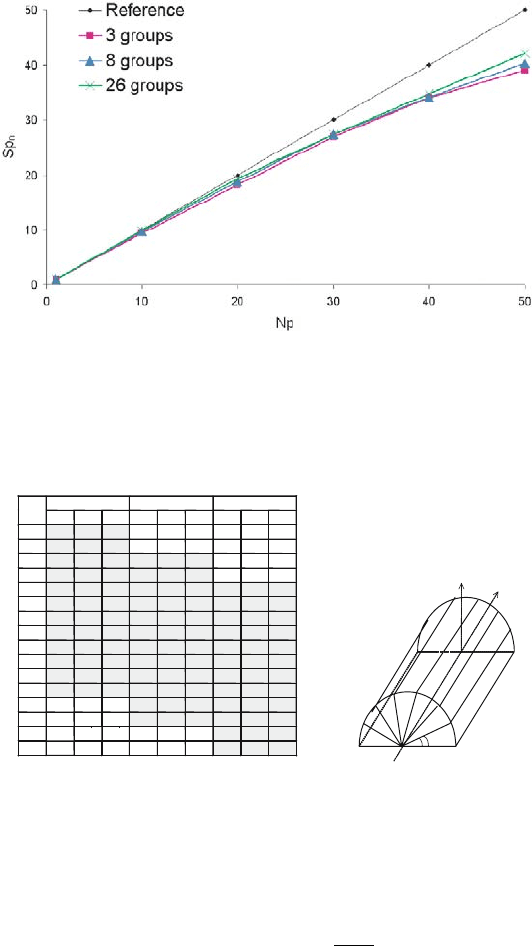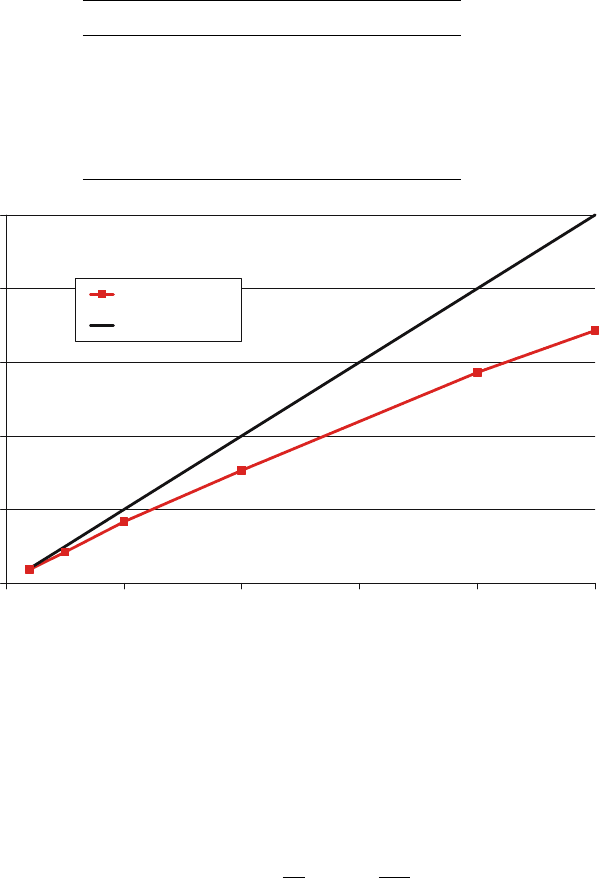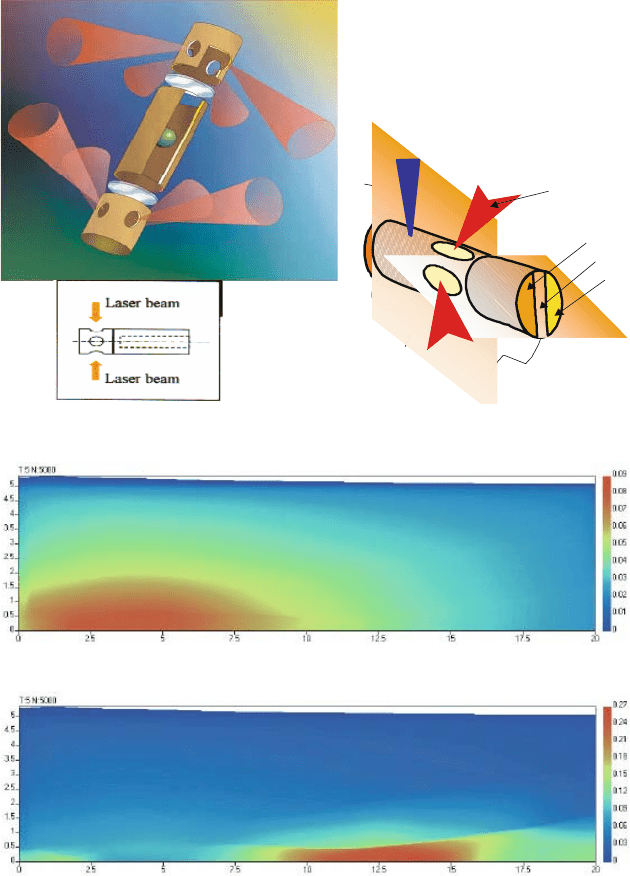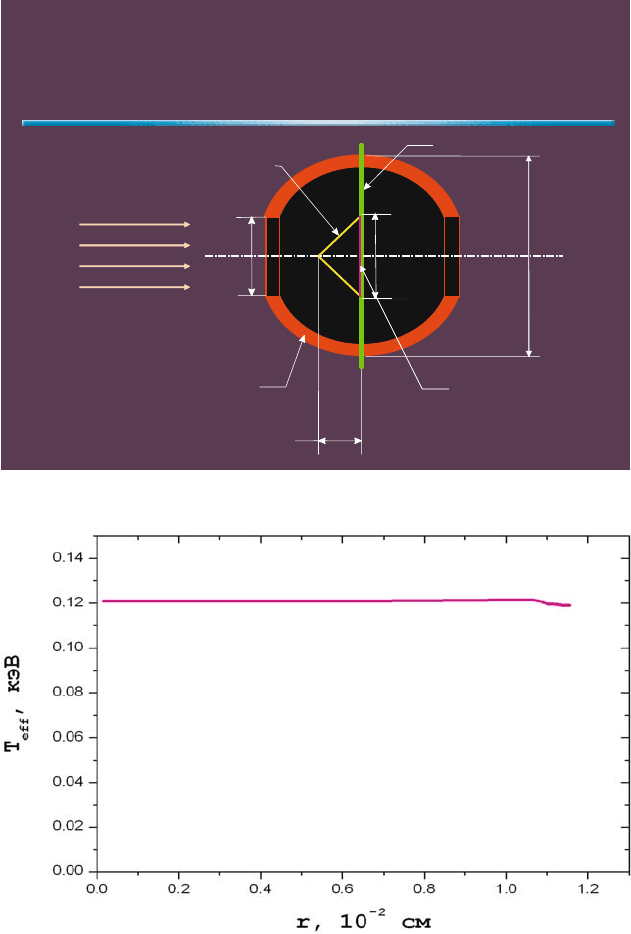Graziani F. (editor) Computational Methods in Transport
Подождите немного. Документ загружается.


346 R.M. Shagaliev et al.
II step: corrector – iterative:
1
ν
i
s+1,ν+
1
2
∆ε
n+1
i
∆t
+ L
s+1,ν+
1
2
∆ε
n+γ
i
+α
i
∆
s+1,ν+
1
2
ε
n+γ
i
−l
NI
j=1
β
ij
∆
s+1,ν+
1
2
ε
n+γ
j
=(1− l)
1
2π
×
NI
j=1
β
ij
s+1,ν
∆ε
(0)n+γ
j
+
1
2π
NI
j=1
β
ij
s+
1
2
∆ε
(0)n+γ
j
,
s+1,ν+
1
2
∆ε
i
=
s+1,ν+
1
2
ε
i
−
s+1,ν
ε
i
1
v
i
s+1,ν+1
∆
2
ε
n+1
i
∆t
+ L
s+1,ν+1
∆
2
ε
n+γ
i
+α
i
∆
2
s+1,ν+1
ε
n+γ
i
−
NI
j=1
β
ij
∆
2
s+1,ν+1
ε
n+γ
j
=(1− l)
1
2π
×
NI
j=1
β
ij
s+1,ν+
1
2
∆ε
(0)
n+γ
j
−(1 − l)
1
2π
NI
j=1
β
ij
s+
1
2
,ν
∆ε
(0)
n+γ
j
,
s+1,ν+1
∆
2
ε
i
=
s+1,ν+1
∆ε
i
−
s+1,ν+
1
2
∆ε
i
Numerical studies of the KM3 method
Benchmark problem «Tube»:
Region 2 (10×100)
Region 1 (10×100)
Z
R
0
10
1
1.2
Fig. 15. Problem geometry
The number of iterations in region 2 (NIter
ν
= 1, l = const = 0.5)
∆t =0.1 · 10
−10
sec ∆t =0.5 · 10
−10
sec ∆t =0.1 · 10
−9
sec
Simple Simple Simple
Step No. Iteration KM KM3 Iteration KM KM3 Iteration KM KM3
1 19108 14 14 28696 26 26 26454 35 35
5 3332 24 20 6363 121 88 7960 238 174
10 1559 27 20 8477 101 75 9146 179 135
t, ??? 2880 61 47 7020 233 184 8580 435 347
Finite-Difference Methods Implemented in SATURN Complex 347
1.4 Parallel Techniques
As mentioned above, the numerical solution to many classes of multidi-
mensional time-dependent problem classes entails high computational costs.
Therefore, parallel algorithms oriented to advanced high-performance multi-
processor computer systems are required. The development of highly efficient
algorithms for parallelization of the problem class under discussion is an in-
volved methodological problem. There are a number of objective reasons for
this, among which the following should be primarily mentioned.
1. As known, implicit schemes are mainly used for the numerical solution to
the transport problems, hence, spatial grid cell computations should be
performed in some strictly determined sequence. When using nonorthog-
onal spatial time-varying grids, the sequence of the cell computation can
be different at different timesteps. In other words, in parallelization of
this problem class over spatial variables it is very hard, in contrast to the
problem classes using explicit numerical methods, to ensure a simultane-
ous uniform loading of all processing elements used.
2. In numerical solution to nonlinear transport equations the costs of the
transport equation coefficient computation are significantly different at
different spatial points, which leads to an additional disbalance of the
parallel computations.
3. In the numerical solution of the problem class under discussion a number
of other physical processes must be calculated simultaneously with the
simulations of the transport processes in separate subregions, which also
significantly influences the parallel computation balance.
We have developed a fine-grain parallelization method to solve the above
problems on multiprocessor computers in the spatial two-dimensional ap-
proximation. The method is oriented to the case of arbitrary nonorthogonal
spatial grids. It admits spatial problem decomposition to a fairly large num-
ber of processors with arrangement of balanced computations.
Principal concepts of the fine-grain parallelization method
• The principle of spatial decomposition of the initial system to subdomains
(paradomains) for the data allocation over the processors
• The pipeline computation of the paradomain along the particle flight direc-
tions with internal boundary conditions calculated at the current iteration,
which preserves the computation efficiency and accuracy
• Loading of temporarily idling processors with profitable computations re-
lating to calculation of additional coefficients, which the solution is ex-
pressed by.
• Using a combined approach with simultaneous parallelization over the sub-
domains and by angular variable µ.
• When solving the multi-group transport problems, the spatial decompo-
sition principle is used in combination with the parallelization by energy
groups.

348 R.M. Shagaliev et al.
Fig. 16. Acceleration factor versus the number of processors
Time diagram of the solution to the 3D transport equation with
p
arallelization
R
Φ
Z
Algorithm for pipeline parallelization of 3D
transport equation
Clock Process 1
Process 2 Process 3
µϕΦµϕΦµϕΦ
1 1 1 1------
2 1 1 2------
3 1 2 1 1 1 3-- -
4 1 2 2 1 1 4-- -
5 1 3 1 1 2 3 1 1 5
6 1 3 2 1 2 4 1 1 6
7 2 1 1 1 3 3 1 2 5
8 2 1 2 1 3 4 1 2 6
9 2 2 1 2 1 3 1 3 5
10 2 2 2 2 1 4 1 3 6
11 2 3 1 2 2 3 2 1 5
12 2 3 2 2 2 4 2 1 6
13 - - - 2 3 3 2 2 5
14 - - - 2 3 4 2 2 6
15------2 3 5
16------2 3 6
The 3D particle transport
equation is solved in the
cylindrical coordinate system
Fig. 17. Results of the numerical study of the 3D transport equation parallelization
on a model problem
The results of the numerical studies of the parallelization algorithm effi-
ciency on one model spherical problem are presented below.
Efficiency estimation with the magnification method. The problem size
on each processor remains constant. Sp
N
=
T
1
∗N
T
N
. 900 computational cells
per processor. The results are presented in Fig. 16.

Finite-Difference Methods Implemented in SATURN Complex 349
Results of the numerical studies of efficiency
Nproc Sp
n
En, %
21.84 92
54.23 85
10 8.33 83
20 15.3 77
40 28.6 71
50 34.3 69
0
10
20
30
40
50
01020304050
Nproc
Sp
n
Computation
Reference
Fig. 18. Acceleration factor versus the number of processors
Algorithm for Pipeline Parallelization of 3D Transport Equation
The pipeline parallelization algorithm has been developed by us and has
been being successfully used for many years in solution to three-dimensional
transport problems (Fig. 17).
The efficiency estimation with the refinement method. The total size of
the problem remains constant. Sp
N
=
T
1
T
N
, E
N
=
Sp
N
N
∗ 100%.
Problem parameters: 8 energy groups, 96 particle flight directions (S
8
),
250000 3D spatial cells. The results of the numerical studies are summarized
in the next table and in Fig. 17.

350 R.M. Shagaliev et al.
1
3
2
I
II
III
1- holder,
2- laser beams,
3- «ILLUMINATOR»,
4- cylindrical box,
I – III– zones where materials
to be studied are located.
Numerical simulation of experiments on laser facility ISKRA-5
Fig. 19. The “illuminator” target
(a)
(b)
Fig. 20. Distribution of effective temperature of radiation (a) and electrons (b)
inside the cylinder at time 5 ns. Length scale: 100 µm; temperature scale: keV

Finite-Difference Methods Implemented in SATURN Complex 351
Design of the “labyrinth” target used for X-ray field generation
on the sample surface in the experiments to study the equation of
state with the shock compression method on facility «ISKRA-5»
d
1
d
2
cone
film
box
disk
d
3
D
b
ox
laser
radiation flux
Fig. 21. The “labyrinth” target
Fig. 22. Distribution of radiation effective temperature in the outlet cross section.
“Labyrinth” problem

352 R.M. Shagaliev et al.
(a)
(b)
Fig. 23. Distribution of electron temperature (a) and effective temperature of
radiation (b) at the time of peak laser pulse. “Labyrinth” problem
1.5 Some Examples of Computations for 2D Application Problems
The above-discussed numerical methods and algorithms are widely used
presently for computations of different application problems in multidimen-
sional geometries.
To demonstrate the capabilities of the methods developed, below are some
results of the computations for 2D coupled time-dependent problems that
describe experiments on laser facility ISKRA-5 (Figs. 19–23).
Implicit Solution of Non-Equilibrium
Radiation Diffusion Including Reactive
Heating Source in Material Energy Equation
Dana E. Shumaker
1
and Carol S. Woodward
2
1
Lawrence Livermore National Laboratory
shumaker1@llnl.gov
2
Lawrence Livermore National Laboratory
cswoodward@llnl.gov
1 Introduction
In this paper, we investigate performance of a fully implicit formulation and
solution method of a diffusion-reaction system modeling radiation diffusion
with material energy transfer and a fusion fuel source. In certain parameter
regimes this system can lead to a rapid conversion of potential energy into
material energy. Accuracy in time integration is essential for a good solution
since a major fraction of the fuel can be depleted in a very short time. Such
systems arise in a number of application areas including evolution of a star [1]
and inertial confinement fusion [2].
Previous work has addressed implicit solution of radiation diffusion prob-
lems [3–8]. More recent work has looked at implicit and semi-implicit so-
lution of reaction-diffusion systems. In general, a fully implicit method has
been found to be the most accurate method for difficult coupled nonlinear
equations [9, 10]. In previous work, we have demonstrated that a method of
lines approach coupled with a BDF time integrator and a Newton-Krylov
nonlinear solver could efficiently and accurately solve a large-scale, implicit
radiation diffusion problem [7, 8]. In this paper, we extend that work to in-
clude an additional heating term in the material energy equation and an
equation to model the evolution of the reactive fuel density. This system now
consists of three coupled equations for radiation energy, material energy, and
fuel density. The radiation energy equation includes diffusion and energy ex-
change with material energy. The material energy equation includes reaction
heating and exchange with radiation energy, and the fuel density equation
includes its depletion due to the fuel consumption.
In many applications, the added heat source involves a reaction rate with
a strong nonlinear dependence on material temperature and thus provides a
good test for an implicit solution method. We use an approximation to the
reaction rate valid for temperature regimes less than 1 keV where the rate
has its strongest dependence on material temperature. In particular, the rate

354 D.E. Shumaker and C.S. Woodward
depends on temperature to the fifth power in this regime. While the actual
reaction rate drops off at high temperature, we use the the fifth power fit for
any temperature in order to investigate the performance of implicit solution
techniques on problems with strong nonlinearities.
The remainder of this paper is organized as follows. The next section
describes the model and presents the equations we are solving. Section 3
describes the implicit solution method we employ, and Sect. 4 presents nu-
merical results illustrating accuracy and efficiency of the solution method.
Conclusions are presented in the last section.
2 Mathematical Model
We consider a flux-limited formulation of radiation diffusion including a
model for heating due to a fusion source term. The evolution of the fusion
fuel density is determined by an equation which models the depletion of the
fuel as its fusion energy is added to the material energy.
The radiation diffusion model is given by [11, 12]
∂E
R
∂t
= ∇·
c
3ρκ
R
(T
R
)+
∇E
R
E
R
∇E
R
+ cρκ
P
(T
M
) ·
aT
4
M
− E
R
, (1)
where E
R
(x,t) is the radiation energy density (x =(x, y, z)), T
M
(x,t)isthe
material temperature, ρ(x) is the material density, c is the speed of light,
and a =4σ/c where σ is the Stephan–Boltzmann constant. The Rosseland
opacity, κ
R
, is a nonlinear function of the radiation temperature, T
R
,which
is defined by the relation E
R
= aT
4
R
. The Planck opacity, κ
P
, is a nonlin-
ear function of material temperature, T
M
, which is related to the material
energy through an equation of state, E
M
= EOS(T
M
). In this paper, when
we use variable opacity and specific heat their values are taken from the
LEOS equation-of-state package [13] which determines opacities and specific
heats via table look-up. In some simplified test problems we use the relation,
E
M
= ρc
v
T
M
, for the specific heat and constant values for opacities. In the
flux limiter, the norm ·is taken to be the l
2
norm of the gradient vector. In
the simulations presented here we use either Dirichlet or Neumann boundary
conditions on the radiation energy.
This equation is solved in conjunction with two other equations. One
equation expresses the conservation of material energy [11, 12] given by
∂E
M
∂t
= −cρκ
P
(T
M
) ·
aT
4
M
− E
R
+ e
r
σ
v
ρ
F
2
T
M
T
0
5
. (2)
The heating term is controlled by a fusion model [14](p. 13) of fuel density
given by

Implicit Solution of Non-Equilibrium Radiation Diffusion 355
∂ρ
F
∂t
= −σ
v
ρ
F
2
T
M
T
0
5
, (3)
where
ρ
F
is the fuel density. This evolution equation has been used in con-
trolled fusion models [15].
The fit to the reaction rate gives, σ
v
=1.43 × 10
3
cm
3
sec−g
, with a ref-
erence temperature, T
0
, of 1 keV. For the energy per reaction we use,
e
r
=1.35 × 10
18
erg
sec−g
. This value corresponds to the alpha particle energy
from deuterium tritium fusion. We neglect the neutron energy from the reac-
tion and assume the alpha particle has zero range, thus depositing its energy
locally.
Both the material energy and the fuel density equations contain the non-
linear temperature dependence term (T
M
/T
0
)
5
. This dependency is a good
fit to a tritium-deuterium reaction rate at low temperature (less than a few
keV) such as in a tokamak fusion experiment [16]. The reference temperature,
T
0
, is a normalization constant (1 keV) included to simplify the units of the
fitted reaction rate σ
v
. The actual reaction is less strongly dependent on T
M
above 1 keV, but, as noted above, we will use this approximation above that
temperature.
The fusion fuel is assumed to be a 50:50 mixture of tritium and deuterium
with
ρ
F
representing the tritium or deuterium density. The binary nature of
the reaction leads to the
ρ
F
2
dependence in the reaction rate. The energy
per reaction added to the material energy equation is e
r
.
Obviously there are a significant number of physical processes omitted
from this simple model. One relevant to the deposition of heat, is that we as-
sume the energy of reaction is deposited locally. The correct physical process
would distribute the heat spatially due to the finite range of the charged
particles in the matter. We chose not to model this nonlocal effect here.
3 Numerical Methods
In this section we present both the spatial and temporal discretization meth-
ods used for solution of the system (1)–(3).
3.1 Spatial Discretization
For spatial discretization, we employ a cell-centered finite difference scheme.
We use a tensor product grid with N
x
,N
y
, and N
z
cells in the x, y, and
z directions, respectively. Defining E
R,i,j,k
(t) ≈ E
R
(x
i,j,k
,t), E
M,i,j,k
(t) ≈
E
M
(x
i,j,k
,t), and ρ
F,i,j,k
(t) ≈ ρ
F
(x
i,j,k
,t) with x
i,j,k
=(x
i
,y
j
,z
k
), and
E
R
≡
⎛
⎜
⎝
E
R,1,1,1
.
.
.
E
R,N
x
,N
y
,N
z
⎞
⎟
⎠
E
M
≡
⎛
⎜
⎝
E
M,1,1,1
.
.
.
E
M,N
x
,N
y
,N
z
⎞
⎟
⎠
ρ
F
≡
⎛
⎜
⎝
ρ
F,1,1,1
.
.
.
ρ
F,N
x
,N
y
,N
z
⎞
⎟
⎠
,
